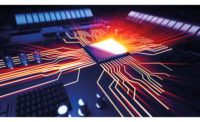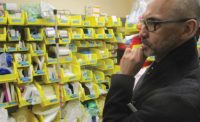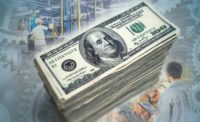
They are called environmental chambers, but torture chambers might be a more accurate name. Here, in these small, rectangular boxes, products are subjected to extreme heat or cold. In other chambers products are violently shaken or battered with jets of water and sprays of salt and dust. Products are submerged, suffocated, battered, twisted and eventually broken--it is only when a product breaks that its defects can be identified and fixed.
In the real world, the finished product may never encounter the extreme stresses that the unfortunate test products face during environmental testing. But the data discovered during these tests will help ferret out problems before products go into mass production or get sent to customers.
"In an environmental test, you want to see if the hardware will operate correctly in those environments," says Wayne Tustin, founder of the Equipment Reliability Institute (Santa Barbara, CA). Tustin, a pioneer in vibration and shock testing whose experience dates back to testing at Boeing (Seattle) in 1948, is a consultant to industry and conducts seminars on environmental testing. "If people are concerned about how their product will be affected by temperature, they can put that item into a heated and cooled climatic chamber. Or, if they are worried about equipment failing because of vibration or shock, it can be placed into a shaker."
The use of environmental testing is growing in both preproduction and post-production applications as companies look to improve the quality and reliability of their products. While most products will never have to endure -50 F temperatures, the fact that a product can stand up to that abuse means that it will probably have a long working life. Many companies are investing in available equipment that is on the market, while other companies are looking to outsource the task, says Jeffrey Schutt, general manager of Trace Laboratories, Central (Palatine, IL). Trace Laboratories is a certified, independent test laboratory.
"The awareness of environmental testing and its importance to the life of a product is growing in the manufacturing base," says Schutt. "Many of our customers can do the tests themselves, but they, or their customers, want a third party to conduct the tests. They don't want even a hint of the fox guarding the hen house. We don't care if a product passes or fails."
Environmental tests seemingly can be anything that the imagination can conjure--such as baking a product at 177 C while simultaneously shaking it at up to 2,000 Hz. But the tests are generally broken into two types, climatic and dynamic. Temperature, humidity and altitude are three examples of climatic tests. Dynamic tests include vibration and shock.Temperature tests involve placing the product in a sealed environmental chamber that can typically vary temperatures by more than 600 F, from -310 F to +300 F. In some cases, such as at BFGoodrich Aircraft Sensors (Burrsville, MN) temperatures can be simulated from -310 F to 2,400 F. In addition, temperatures can be rapidly ramped up and down, to place even greater stress on the product.
Make 'em sweat
Humidity tests are also common. One company, Qualtest Inc. (Orlando, FL) says it can concurrently cycle humidity with temperature from 5% RH to 98% RH.
Many labs, such as Northrup Grumman (Rolling Meadows, IL) and Trace Laboratories conduct salt fog tests. Other similar tests conducted by Trace and others include the use of road dust, sprays of granular Portland cement or any other particulate that might affect the product in the field.
Some products are placed in wind tunnels that can reach velocities up to 500 mph with variable temperature and icing conditions. Products can also be exposed to blowing sand that is heated and reaches speeds of more than 3,500 feet per minute. Altitude tests can simulate a product at heights of 100,000 feet or more.
Vibration testing has long been a means to test products, but the results weren't always reliable. In the early 1950s, the first attempts at launching rockets from Cape Canaveral were disastrous. They blew up at the moment of ignition, or after getting just a few feet off the ground. Government scientists were stumped until they discovered the immense vibration that these new rocket engines were generating.
"Until the mid-1950s, the vibration test that was conducted was sinusoidal," says Tustin. "That is all we really knew of at that time. A major source of vibration in that era was propellers on propeller-driven aircraft. Once we started using jets and rockets, the situation changed, and those old fashioned tests weren't capable of finding the problems. We needed to find a better representation of the real world--the real world of flying through turbulence, of firing a rocket engine through the air. That is when we started to do random vibration testing."
Today, sinusoidal tests, those tests that ramp up resonances one sequence at a time, have been replaced by random vibration testing that Tustin says is more "real world." In random vibration tests, all possible resonances are excited simultaneously and the effects are unpredictable. Sinusoidal tests are still used to test such as accelerometers.
"Random vibration is unpredictable and this unpredictability happens in the field. That's why we want it to happen in the lab," Tustin explains. "When you are going down the road, you don't know what the bumps are going to be."
Life in the fast lane
Predicting a product's life cycle can be done quickly by placing severe stresses on the product, in effect "accelerating" its "life." As Harry McLean points out in his book, "HALT, HASS and HASA Explained: Accelerated Reliability Techniques" (2000 ASQ), there are many different terms for accelerated life testing. While they have different names, the idea is to eliminate process weaknesses and improve design and product quality, according to McLean.
The test system that started it all, however, is Environmental Stress Screening (ESS). In May 1979, Willis Willoughby, head of the U.S. Navy's procurement department, told Navy contractors that they had to perform ESS on the products they sold to the Navy. Willoughby prescribed varying temperature and random vibrations in which the products had to be tested. For many large, technical companies, this was the first they heard of random vibration, according to Tustin.
"At the time that Willoughby put out the document, the Navy was plagued with airborne and shipborne systems that weren't working reliably and it needed to warehouse spare parts and employ highly trained repair people," a problem that ESS was designed to combat, says Tustin.
"The concept of ramping up temperatures and putting extreme stresses on a product will force many problems to show up. Just like random vibration, this testing finds weaknesses that don't show up in the lab that might show up in service." Tustin says. "You can avoid a lot of service problems by environmental stress screening."
ESS has spawned new stress systems of which HALT, or Highly Accelerated Life Test, is one of the most popular. HALT is a reproduction test system that is meant to find defects before the product goes into full production. The pilot product is put through a regiment of stresses as part of its development. The stresses are applied to the product while it is in operation in order to find weakness on pilot units and fix them. At this point, the product may need to be redesigned or the manufacturing methods need to be changed.
"HALT and other kinds of environmental tests are the opposite of most tests," says Schutt. "With most tests, you want to pass, but the objective of this is to fail so that the failures can be identified so the customer can design around the problem."
Tech Tips
- Environmental tests such as temperature, vibration, and particulates can detect potential problems in a new product, discover why a product failed or determine the life of a new product.
- Many products are put through different stresses simultaneously such as heating and shaking.
- Accelerated testing systems such as ESS and HALT can uncover latent defects by "accelerating" the life of the product.





